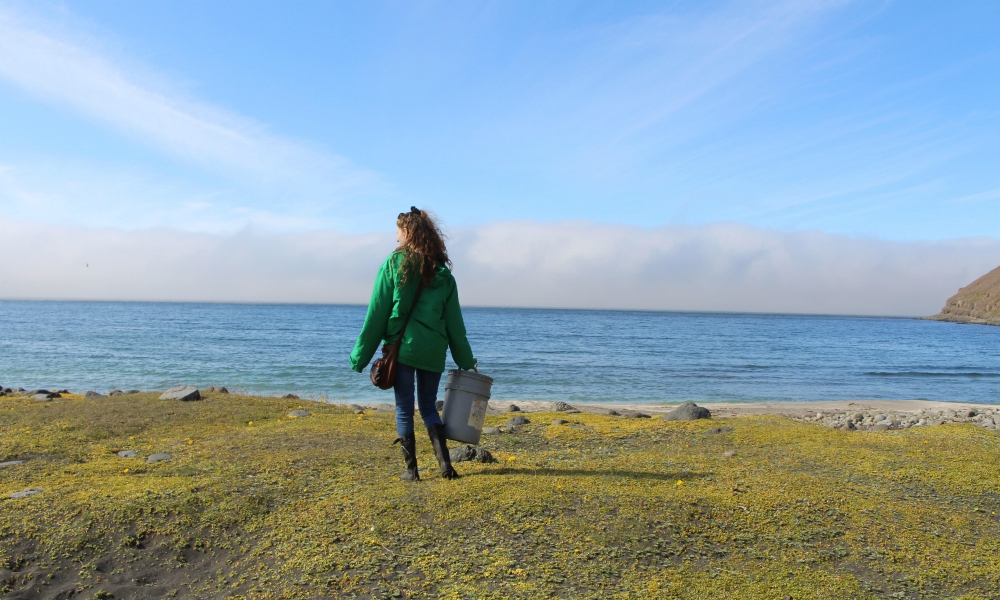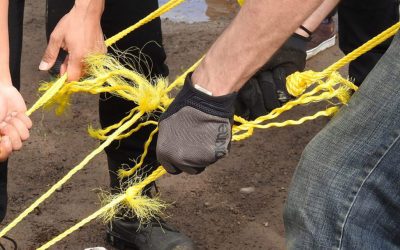Cleaning the Beaches in Iceland’s Remote Westfjords
Photo by Sean O’Rourke
By Amy O’Rourke
Editor’s Note: I selected this article as my staff pick. I love the diary format — being taken through each day of Amy O’Rourke’s beach-cleaning expedition reveals so many unexpected barriers and celebrations. Beyond that, it’s full of information and statistics that ramp up the urgency with every paragraph. By the end of the article, I feel ready to do my part. Luckily, the author provides plenty of suggestions for anyone to undertake their own beach-cleaning endeavours.
Ever since our ancestors began to resemble modern humans, the planet’s oceans have helped us flourish, supplying nourishment and facilitating trade and travel. After AD 874, for instance, the North Atlantic offered a route to Iceland for Norse settlers in search of a better life — and subsequently kept their communities well-fed. Over time, some humans grew to believe that the oceans were simply too vast and their resources too plentiful to ever be impacted by human activity. As a result, many societies have long treated these waters as dumping grounds — places to toss refuse without second thought. During the past few decades, however, this attitude has shifted in conjunction with a growing recognition that the staggering quantities of non-biodegradable oceanic debris we’ve created are not going anywhere anytime soon.
When I moved to Iceland from Canada in 2017 to pursue a Masters in Coastal and Marine Management at the University of the Westfjords in Ísafjörður, I was shocked to learn that, despite its relative isolation and low population, even this Arctic archipelago is not beyond the reach of marine pollution. As a result of this, I decided to focus my thesis research on marine debris in Iceland’s Westfjords. Below, I describe a series of beach clean-ups I did in July 2019 that were documented by my brother, Sean, while he was visiting from out of town.
DAY ONE — The first beach north of Drangsnes
The first beach that I took my brother to was situated along the Strandir coast, half an hour north of the small village of Drangsnes, a community of just 67 inhabitants. The Westfjords — a fjord-lined peninsula jutting out of northwestern Iceland — is considered one of the country’s most remote regions, but even by Westfjords’ standards, this beach was out of the way. Despite its isolation, there was an appalling amount of trash here — the vast majority of which, unsurprisingly, was plastic.
The Arctic now has a higher concentration of plastic than the infamous Great Pacific Garbage Patch.
Since the 1950s, humankind has collectively produced roughly 8.3 billions tonnes of plastic — a material that never degrades into its constituent parts, but rather breaks into smaller and smaller pieces. Global production rates are steadily rising too, with cumulative plastic production anticipated to hit 35 billion tonnes by 2050. Each year, approximately 1.4 million tonnes of plastic end up in our oceans — the equivalent of one garbage truck-load per minute.
On this secluded Icelandic beach, there were more plastics than seashells. We mostly gathered small, hard plastics (likely from buoys and fishing crates), ropes, nets, and bags, but we also found ten shoe soles and some plastic bins too big to move. These findings, unfortunately, were not unusual — it is becoming increasingly common for marine waste from North America and Europe to hitch a ride on the Gulf Stream before washing up on Arctic shores. Ocean currents along Strandir also make this area a hotspot for trash — and driftwood — from Russia. Here’s a particularly sobering fact: the Arctic now has a higher concentration of plastic than the infamous Great Pacific Garbage Patch.
We stopped cleaning this beach once we had filled our vehicle with as much trash as it could fit. It was disappointing to leave debris behind, but what we saw nearby — a bird carcass riddled with plastic and an oystercatcher nesting in garbage — reminded us that removing any amount of waste helps. Each year, plastics kill an estimated 100,000 marine animals and a whopping 1,000,000 seabirds.

Bird carcass full of plastic. Photo by Sean O’Rourke.
DAY TWO — The second beach north of Drangsnes
For our second excursion, Sean and I traveled to another beach near Drangsnes. What we found was similar to the prior clean-up: hard plastic pieces, ropes, nets, and other discarded fishing gear. There was far more garbage here than the hundred or so persons who call Strandir home could possibly produce on their own, especially when you consider that beach trash constitutes only a tiny portion of overall marine debris. Some common plastics are denser than seawater and susceptible to biofouling, meaning they sink and probably do not wash ashore.
As per usual, most debris here could be traced back to the global fishing sectors, but some stemmed from the dumping of raw sewage into local waters. Even a country considered as notoriously progressive as Iceland still pipes sewage directly into the ocean. This this is actually common practice among Western nations. Communities across my home country, Canada, for example, collectively dump over 100 billion litres of untreated sewage into rivers, lakes, and oceans each year. Outside of Reykjavík, Iceland’s capital, there is little to no wastewater treatment infrastructure. Small communities often simply do not have the financial means to support such projects due to their small populations.

The second beach north of Drangsnes. Photo by Sean O’Rourke.
DAY THREE — Bolungarvík Beach
The third beach we cleaned was just outside of beautiful Bolungarvík, a community home to around 950 persons. Despite its proximity to town, we only gathered a handful of debris from this beach, consisting mostly of ropes, fishing line, netting pieces, debris associated with fish processing, and wires.
Oceanic plastics are not just a problem for wildlife: they are entering the human food chain too, showing up in the fish and shellfish that we eat, and even in our sea salt.
During my research, I have found that different types of beaches in the Westfjords accumulate different types of trash. On one hand, sandy beaches like this one, and those with kelp, commonly accumulate plastic ropes, longline headline and snoods, gillnetting, and trawl net cuttings. Sometimes swaths of this fishing gear conglomerate together, forming large, heavy masses that I’ve dubbed ‘beach blobs.’ Depending on rock size, rocky beaches, on the other hand, tend to trap small, hard plastic pieces. These different materials each pose a unique set of threats to wildlife. Ropes and netting can cause entanglement, and small plastics are often mistaken for food. When marine organisms ingest plastic, they feel artificially satiated but absorb no nutrition, which can lead to starvation.
Oceanic plastics are not just a problem for wildlife: they are entering the human food chain too, showing up in the fish and shellfish that we eat, and even in our sea salt. Many plastics contain toxic chemicals known to cause detrimental effects. Over time, ingested plastics accumulate in our bodies, but due to a lack of research, we don’t yet know exactly how this will affect human health in the long-run. Animal studies, however, suggest the health outcomes are not good.
DAY FOUR — Skálavík Beach
Our plans to clean up Skálavík Beach, located a half hour northwest of Bolungarvík, were frustratingly foiled by the local fauna. Arctic terns are a highly defensive bird that typically nest on beaches, and the ones on Skálavík Beach did not stop dive-bombing us until we left. Fortunately, this beach did not appear to have too much trash on this occasion, though on my first visit, I removed nearly 10 beach blobs, as well as buckets mostly filled with fishing-related debris.

Dive-bombing Arctic terns. Photo by Sean O’Rourke.
DAY FIVE — Isafjörður Harbour
The last spot my brother and I cleaned before his flight back to Canada was the harbour of Isafjörður, the Westfjords’ capital and largest town, with roughly 2500 inhabitants. Here, the consequences of industrial activity and of piping raw sewage into the ocean were most prominent. We found unwoven plastic threading used for packaging shrimp, q-tips, and other hygiene products, like tampon wrappers, that had been thoughtlessly flushed away. There was also a large quantity of litter from fishermen and the nearby fish processing plants such as packing straps, styrofoam, labels, latex gloves and too many cigarette butts to count. Though cigarette filters may appear to be made from cotton, they’re usually comprised of synthetic polymers that do not readily degrade. Even worse, cigarette butts contain high concentrations of toxic chemicals — arsenic, cadmium, and lead, to name a few — and have been found to poison fish and other aquatic species. A single cigarette butt is so toxic that it can kill half of the fish swimming in a litre of water.
What can you do to help?
If learning about my research has inspired you to clean a beach or two on your own, all you need are rubber gloves and boots, bags or buckets, and a bit of time — you will probably be surprised by how good you feel afterwards. Personally, I find that tangibly improving the environment through beach-cleaning is meaningful, meditative, and exciting — it feels like hunting for treasure, though with more at stake. If you don’t live near a coast, don’t fret! There are many opportunities to remove litter everywhere. Spending your weekend camping? Do a sweep around your site and pick up any trash previous occupants left behind. Out for a hike? Snatch any garbage you encounter on the trail and pack it out. Or, if you’re not a fan of the outdoors, you can write letters to local politicians urging them to promote policies that discourage plastic production and encourage the fishing sector to transition from using plastic nets, lines, and other equipment to those made from bioplastics, which biodegrade if gear is lost or discarded. Just this year, Plantee Bioplastics, a fishing-oriented bioplastics venture in Kingston, Ontario, received a large grant from the Canadian Federal Government. And if you live in a community that dumps raw sewage into local waters, like many throughout Canada, be mindful that you do not flush non-biodegradable items. It can sometimes be difficult to remember that humans do not live in a bubble separate from the rest of the world, but our waste enters our environments, which we are very much interconnected with and dependant upon.
There is a popular Chinese proverb that states, “the best time to plant a tree was 20 years ago. The second best time is now.” Likewise, the best time to start cleaning up our beaches and oceans was years ago, but the second best time is today.

Cleaning Skálavík Beach. Photo by Sean O’Rourke.
Amy O’Rourke’s full thesis is available here.
Amy O'Rourke recently completed her Masters of Resource Management, with a specialization in Coastal and Marine Management, at Háskólasetur Vestfjarða (University of the Westfjords) in Ísafjörður, a remote community in Iceland’s Westfjords. Her thesis and ongoing research centres around the collection and classification of marine debris, seeking to understand how specific fishing sects and operations contribute to the vast quantity of debris throughout Iceland’s coastal environments. Amy grew up in Calgary, Alberta and completed a BAH in Political Science and English at Queen’s University. Here, she also partook in environmentally focused extracurriculars, cementing her passion for enacting tangible environmental change. Follow her ongoing beach clean ups on Instagram: @beachtrash_.



